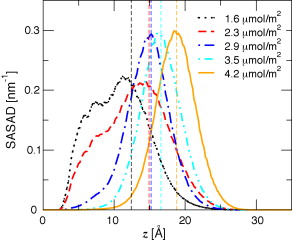J. Chromatogr. A 1204, 11-19 (2008)
Particle-based Monte Carlo simulations were employed to examine the effects of bonding density on molecular structure in reversed-phase liquid chromatography. Octadecylsilane stationary phases with five different bonding densities (1.6, 2.3, 2.9, 3.5, and 4.2 μmol/m2) in contact with a water/methanol (50/50 mol%) mobile phase were simulated at a temperature of 323 K. The simulations indicate that the alkyl chains become more aligned and form a more uniform alkyl layer as coverage is increased. However, this does not imply that the chains are highly ordered (e.g., all-trans conformation or uniform tilt angle), but rather exhibit a broad distribution of conformations and tilt angles at all bonding densities. At lower densities, significant amounts of the silica surface are exposed leading to an enhanced wetting of the stationary phase. At high densities, the solvent is nearly excluded from the bonded phase and persists only near the residual silanols. An enrichment in the methanol concentration and a disruption in the mobile phase’s hydrogen bond network are observed at the interface as bonding density is increased.
